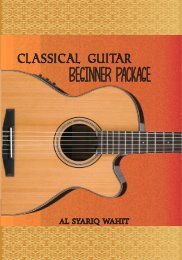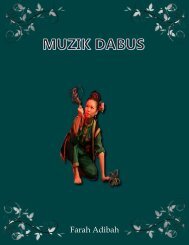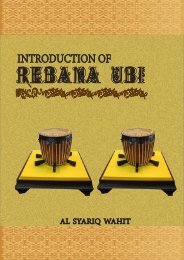Create successful ePaper yourself
Turn your PDF publications into a flip-book with our unique Google optimized e-Paper software.
CLASSICAL guitar<br />
BEGINNER PACKAGE<br />
AL SYARIQ WAHIT
This book was published to fullfill the course requirement for subject MUE620 Digital<br />
Dekstop Publishing under Dr. Ahmad Rithaudin <strong>Md</strong> Noor supervision.
Series Editor: Rahman Dinedja<br />
Series Editorial Assistance: Silva Raju Arumugam<br />
Composition Buyer: Ajwad Tarmizi<br />
Manufacturing Buyer: Tharin Zaquan<br />
Editotial-Production Administration: Ahmad Taib Redzuan<br />
Editorial-Production Services: <strong>Al</strong> Sadiq<br />
For titles that are relevant and material support, visit our online catalog at www.rebanaubi.com<br />
Copyright © 2017 Malay Education, Inc.<br />
<strong>Al</strong>l rights reserved. No part of the material that is protected by copyright notice may be reproduced<br />
or used in any form or by any means, electronic or mechanical, including photocopying, recording<br />
or by any system of information storage and retrieval, without the written permission of the copyright<br />
holder.<br />
To obtain permission to use material from this work, please send a written request to Aiman reza,<br />
Bentong, Pahang, Malaysia or fax your request to online + 607-28944856<br />
<strong>Wahit</strong> Series Holding Sdn Bhd<br />
<strong>Al</strong> <strong>Syariq</strong> <strong>Wahit</strong>,<br />
Rebana Ubi: Introduction / <strong>Al</strong> <strong>Syariq</strong> <strong>Wahit</strong> - 1st ed.<br />
Includes bibilography refference and index.<br />
ISBN 0-123-41259-0<br />
Printed in Malaysia
classical guitar<br />
Beginner Package<br />
<strong>Mohamad</strong> <strong>Al</strong> <strong>Syariq</strong>
CONTENTS<br />
INTRODUCTION 1<br />
GUITAR : TANBUR 3<br />
THE OLDEST KNOWN<br />
ICONOGRAPHIC FOR GUITAR 5<br />
THE GUITAR’S PART 12<br />
GUITAR TUNING 15
Introduction<br />
The guitar is an ancient instrument, the guitar history stated<br />
long time ago, about 4000 years before. Many theories have<br />
been stated about this instrument. It has been said that the<br />
guitar is a development of the lute, or even of the ancient<br />
Greek kithara. Dr. Michael Kasha, the person who conducted<br />
research in the 1960's showed these theory without a<br />
merit. He showed that the lute is a result of a different line
line of development, sharing common ancestors with the guitar, but having<br />
had no influence on its evolution. The influence in the opposite direction is<br />
undeniable, however, the guitar's immediate ancestors were a major influence<br />
on the development of the fretted lute from the fretless, which the Moors<br />
brought with them to Spain.<br />
The exclusive "evidence" for the kithara theory is the similarity between the<br />
greek word "kithara" and the Spanish word "quitarra". It is hard to imagine<br />
how the guitar could have evolved from the kithara, which was a completely<br />
different type of instrument,namely a square-framed lap harp, or "lyre".
Guitar History:<br />
TANBUR<br />
It would also be passing strange if a square-framed seven-string lap harp had<br />
given its name to the early Spanish 4-string "quitarra". Dr. Kasha turns the<br />
question around and asks where the Greeks got the name "kithara", and<br />
points out that the earliest Greek kitharas had only 4 strings when they were<br />
introduced from abroad. He surmises that the Greeks hellenified the old Persian<br />
name for a 4-stringed instrument, "chartar".<br />
The earliest stringed instruments known to archaeologists are bowl harps<br />
and tanburs. Since prehistory people have made bowl harps using tortoise<br />
shells and calabashes as resonators, with a bent stick for a neck and one or<br />
more gut or silk strings. The world's museums contain many such "harps"<br />
from the ancient Sumerian, Babylonian, and Egyptian civilisations. Around<br />
2500 - 2000 CE more advanced harps, such as the opulently carved<br />
11-stringed instrument with gold decoration found in Queen Shub-Ad's<br />
tomb, started to appear.<br />
Bowl Harp / Tanbur
A tanbur is defined as "a long-necked stringed instrument with a small eggor<br />
pear-shaped body, with an arched or round back, usually with a soundboard<br />
of wood or hide, and a long, straight neck". The tanbur probably developed<br />
from the bowl harp as the neck was straightened out to allow the<br />
string/s to be pressed down to create more notes. Tomb paintings and stone<br />
carvings in Egypt testify to the fact that harps and tanburs (together with<br />
flutes and percussion instruments) were being played in ensemble 3500 -<br />
4000 years ago.<br />
At 3500 years old, this is the ultimate vintage guitar (the picture below). It<br />
belonged to the Egyptian singer Har-Mose. He was buried with his tanbur<br />
close to the tomb of his employer, Sen-Mut, architect to Queen Hatshepsut,<br />
who was crowned in 1503 BCE. Sen-Mut (who, it is suspected, was far more<br />
than just chief minister and architect to the queen) built Hatshepsuts beautiful<br />
mortuary temple, which stands on the banks of the Nile to this day.<br />
The Oldest Guitar. Har-Moses<br />
instrument
The Oldest Known Iconographical<br />
for Guitar<br />
To differentiate guitars from other members of the tanbur family, we need to<br />
define what a guitar is. Dr. Kasha defines a guitar as having "a long, fretted<br />
neck, flat wooden soundboard, ribs, and a flat back, most often with<br />
incurved sides".The oldest known iconographical representation of an instrument<br />
displaying all the essential features of a guitar is a stone carving at<br />
<strong>Al</strong>aca Huyuk in Turkey, of a 3300 year old Hittite "guitar" with "a long fretted<br />
neck, flat top, probably flat back, and with strikingly incurved sides"<br />
The lute or <strong>Al</strong>’ud, oud.The Moors brought the oud to Spain. The tanbur had<br />
taken another line of development in the Arabian countries, changing in its<br />
proportions and remaining fretless. The Europeans added frets to the oud and<br />
called it a "lute" - this derives from the Arabic "<strong>Al</strong>'ud" (literally "the wood"),<br />
via the Spanish name "laud". A lute or oud is defined as a "short-necked<br />
instrument with many strings, a large pear-shaped body with highly vaulted<br />
back, and an elaborate, sharply angled peghead".
The name "guitar" comes from the ancient Sanskrit word for "string" - "tar".<br />
(This is the language from which the languages of central Asia and northern<br />
India developed.) Many stringed folk instruments exist in Central Asia to this<br />
day which have been used in almost unchanged form for several thousand<br />
years, as shown by archeological finds in the area.<br />
Many have names that end in "tar", means the number of strings:<br />
1) Two : Sanskrit "dvi" - modern Persian "do" - dotar - two-string instrument<br />
found in Turkestan<br />
2) Three : Sanskrit "tri" - modern Persian "se" - Setar 3- string instrument,<br />
found in Persia (Iran)<br />
3) four : Sanskrit "chatur" - modern Persian "char" - chartar 4-string instrument,<br />
Persia<br />
4) five : Sanskrit "pancha" - modern Persian "panj" - panchtar, 5 strings,<br />
Afghanistan
The Indian Sitar almost certainly took its name from the Persian setar, but<br />
over the centuries the Indians developed it into a completely new instrument,<br />
following their own aesthetic and cultural ideals.<br />
Indian Sitar<br />
By the beginning of the Renaissance, the four-course (4 unison-tuned pairs<br />
of strings) guitar had become dominant, at least in most of Europe. (Sometimes<br />
a single first string was used.) The earliest known music for the<br />
four-course "chitarra" was written in 16th century Spain. The five-course<br />
guitarra battente first appeared in Italy at around the same time, and gradually<br />
replaced the four-course instrument. The standard tuning had already<br />
settled at A, D, G, B, E, like the top five strings of the modern guitar.<br />
In common with lutes, early guitars seldom had necks with more than 8<br />
frets free of the body, but as the guitar evolved, this increased first to 10<br />
and then to 12 frets to the body. A sixth course of strings was added to the<br />
Italian "guitarra battente" in the 17th century, and guitar makers all over<br />
Europe followed the trend.
The six-course arrangement gradually gave way to six single strings. In the<br />
transition from five courses to six single strings, it seems that at least some<br />
existing five-course instruments were modified to the new stringing pattern.<br />
This was a fairly simple task, as it only entailed replacing (or re-working) the<br />
nut and bridge, and plugging four of the tuning peg holes. An incredibly<br />
ornate guitar by the German master from Hamburg, Joakim Thielke (1641 -<br />
1719), was altered in this way.<br />
Guitarra Battente
At the beginning of the 19th century one can see the modern guitar beginning<br />
to take shape. Bodies were still fairly small and narrow-waisted.<br />
6 String Guitar by George Louis<br />
Panormo, 1832<br />
The modern "classical" guitar took its present form when the Spanish<br />
maker Antonio Torres increased the size of the body, altered its proportions,<br />
and introduced the revolutionary "fan" top bracing pattern, in around 1850.<br />
His design radically improved the volume, tone and projection of the<br />
instrument, and very soon became the accepted construction standard. It<br />
has remained essentially unchanged, and unchallenged, to this day.
At around the same time that Torres started making his breakthrough<br />
fan-braced guitars in Spain, German immigrants to the USA - among them<br />
Christian Fredrich Martin - had begun making guitars with X-braced tops.<br />
Steel strings first became widely available in around 1900. Steel strings<br />
offered the promise of much louder guitars, but the increased tension was<br />
too much for the Torres-style fan-braced top. A beefed-up X-brace proved<br />
equal to the job, and quickly became the industry standard for the flat-top<br />
steel string guitar.<br />
Guitar by Antonio<br />
Torres Jurado, 1859.<br />
At around the same time that Torres started making his breakthrough<br />
fan-braced guitars in Spain, German immigrants to the USA - among them<br />
Christian Fredrich Martin - had begun making guitars with X-braced tops.
Steel strings first became widely available in around 1900. Steel strings<br />
offered the promise of much louder guitars, but the increased tension was<br />
too much for the Torres-style fan-braced top. A beefed-up X-brace proved<br />
equal to the job, and quickly became the industry standard for the flat-top<br />
steel string guitar.<br />
At the end of the 19th century Orville Gibson was building archtop guitars<br />
with oval sound holes. He married the steel-string guitar with a body constructed<br />
more like a cello, where the bridge exerts no torque on the top, only<br />
pressure straight down. This allows the top to vibrate more freely, and thus<br />
produce more volume. In the early 1920's designer Lloyd Loar joined<br />
Gibson, and refined the archtop "jazz" guitar into its now familiar form with<br />
f-holes, floating bridge and cello-type tailpiece.<br />
The electric guitar was born when pickups were added to Hawaiian and<br />
"jazz" guitars in the late 1920's, but met with little success before 1936,<br />
when Gibson introduced the ES150 model, which Charlie Christian made<br />
famous. With the advent of amplification it became possible to do away<br />
with the soundbox altogether. In the late 1930's and early 1940's several<br />
actors were experimenting along these lines, and controversy still exists as<br />
to whether Les Paul, Leo Fender, Paul Bigsby or O.W. Appleton constructed<br />
the very first solid-body guitar. Be that as it may, the solid-body electric<br />
guitar was here to stay.
THE GUITAR’S PART
GUITAR TUNING<br />
Before start anything, the guitar must be on tune. Guitars are made out of<br />
wood, and wood reacts to our environment, be it hot, cold, dry or humid. As<br />
such, guitars frequently go out of tune, and they must be tuned to make<br />
them sound good. If you begin learning to play guitar on an out of tune<br />
guitar, it will not sound good to the ear no matter how hard you try, and as<br />
such, it will become discouraging pretty quickly.<br />
When you’re holding your guitar in your lap, the smallest string (closest to<br />
the ground) is called the first string. If you pluck it, you will hear it has the<br />
highest pitch of all six strings. From there, we move towards the sixth<br />
string, which is closest to your face. If you pluck that string, you will hear it<br />
has the lowest pitch of the six.
Now pick a string, any string, and pluck it open. Listen to the pitch. Now,<br />
press down on the string anywhere along the fretboard. You will hear the<br />
pitch of that string is now higher. The most common tuning for guitar is E A<br />
D G B E. We start with the sixth string here, E, then go to A on the 5th<br />
string, and so forth. You’ll need a guitar tuner to help you find the right pitch<br />
for each string. You have tuning your guitar before every single practice session,<br />
and if you’re playing for a while, double checking it in the middle<br />
doesn’t hurt either. If you find the guitar goes out of tune very quickly, it<br />
might be time for some new strings.
<strong>Mohamad</strong> <strong>Al</strong> <strong>Syariq</strong> bin <strong>Md</strong> <strong>Wahit</strong> <strong>Hasim</strong><br />
was born in Kuala Lumpur, but he was<br />
raised in Bentong, Pahang. He who is the<br />
second child of the family never had the<br />
chance to have formal music education, but<br />
that is not the reason he would stop playing<br />
music. He self-taught himself on acoustic<br />
guitar playing. Then he managed to get<br />
himself into Diploma in Music, UiTM and<br />
learn about Classical Guitar.<br />
As the time goes by, he further his study in Bachelor of Music Education<br />
IN UiTM. He studied classical guitar under the guidance Madam<br />
Chua May Ling at the degree level. He hope to be in the future music<br />
industry as a lecturer, and hope to pursue his master and continue<br />
playing the classical guitar. Perhaps through this book, people will<br />
share the knowledege and history about classical guitar.<br />
MYR 30.00










